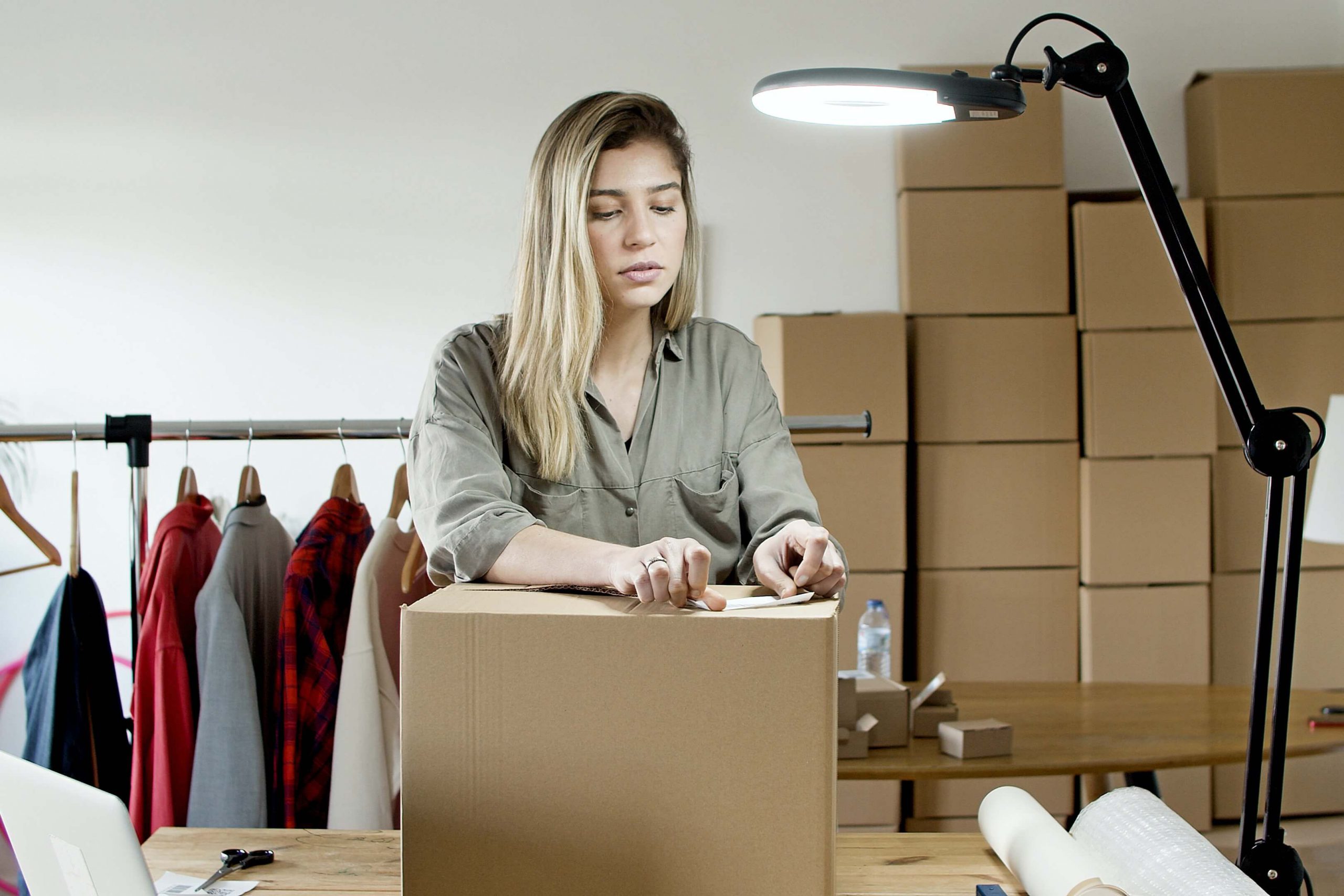This blog post was written in cooperation with Palamo, the sustainable packaging and label provider. Together we take a closer look at the topic of sustainability and optimisation in fulfilment and offer you first starting points to make your fulfilment more efficient. Would you like to know which fulfilment questions you should ask yourself first as an e-commerce start-up? Then take a look at our post on the Palamo blog..
The Christmas season is slowly beginning and planning for this year's parcel shipments in one of the most important seasons of online retail is also in full swing. Between 2019 and 2020, e-commerce purchases during the Christmas season are are up 15 percent according to Google – with no change in sight.
Many assume that CO2 emissions from transporting online purchases would be higher, on average 36% less CO2 is emitted than by brick-and-mortar retail, according to a a study by MIT . However, there is still potential for CO2 savings, as more and more consumers are attaching importance to the sustainability of products and their supply chains. The transformation to environmentally friendly and climate-neutral trade is also called "green logistics". You can read more about it in the blog post "Green Logistics: Sustainability in the Logistics Industry". Currently, the greatest potential for CO2 savings lies in fulfillment, to be more precise in the choice of packaging and packaging strategy, as packaging is often the biggest cause of high emissions in e-commerce. This is due to the high amount of packaging used for transportation, for example, as shown by the MIT survey on CO2 footprints in retail.
Leverage your packaging materials & strategy for more sustainability in e-commerce.
In general, the opportunities for more sustainability in e-commerce fulfillment can be divided into two areas:
1. Packaging material: this includes packaging materials from so-called primary (the first product packaging, e.g. a container of a food product), secondary (e.g. the packaging carton for transportation), and tertiary packaging (e.g. pallets).
2. Packaging strategy: the packaging strategy also plays an important role. This includes how your products are packaged, as well as various ways to adapt your product design to your packaging solution so that they can be packed and shipped as easily as possible.
Tips for reducing packaging materials
Packaging materials are used to protect your products. The trick is to ideally protect your product while not creating unnecessary packaging waste.
Tip #1: Minimize your packaging
Depending on the product you offer your customers and how close you are to your target market, some packaging can be omitted as a first step. One example is the well-known zero waste stores, which offer unpackaged products to consumers and do without plastic packaging, e.g. for vegetables. You can also apply this principle in e-commerce and, for example, completely omit the individual packaging of clothing items in an order.
Tip #2: Use alternative & recycled packaging materials
Every packaging material offers advantages and disadvantages, but when it comes to CO2 savings related to transportation and logistics, some materials are better suited than others: Flexible packaging, such as plastic bags, conforms to your products, minimizes empty space between your product and the packaging, and performs well on environmental footprint: according to Flexpack flexible packaging emits 5x less CO2 than glass. This is because for the same capacity, glass is significantly heavier than plastic, which leads to higher transport volumes. Compared to cardboard, CO2 emissions balance out (Pro Carton). But standard sizes of carton often create empty spaces that take up more space than the product actually needs. This leads to wasted space, as not all packaging is completely filled and consequently to higher CO2 emissions.
Even though plastic is a controversial material, there are sustainable options, such as recycled plastic material. For other packaging materials, more environmentally friendly alternatives can also lead to lower CO2 emissions, as packaging that has already been produced needs to be reused rather than manufactured from scratch. These include recycled paper and cardboard, for example, as well as compostable paper pouches, i.e. biodegradable packaging that leaves no long-term residue.
Tip #3: Use packaging material that can be recycled by customers
According to Consumer Office North Rhine-Westphaliathe amount of packaging in Germany per capita is 226.5 kg with an increasing tendency. End consumers use many products, especially food and cosmetics, and have no use for the resulting packaging waste. This leads to mountains of waste and the difficulty of recycling plastics in particular. This is where the potential for savings lies with recyclable packaging materials for your products. One example is Fairtrade tea manufacturer Charitea, who offers which offers online inspiration for reusing the glasses, e.g. as soap dispensers. Already used packaging that is used for a new purpose is also called upcycling. Instead of packaging your products solely for protection, you can consider how your consumers can use your packaging a second time or even with new uses.
Tips on packaging strategies and product optimization
In addition to the packaging material, the packaging strategy is also an important aspect for eliminating unnecessary CO2 emissions. This applies to the way you pack your products as well as the logistics-oriented product design.
Tip #4: Pack your products smart
Even if you switch to sustainable packaging materials, your packages should also be packed as smartly and space-efficiently as possible to avoid blocking unnecessary transport space and over-packing. Therefore, it is important to choose your e-commerce shipping boxes to match your products. For this purpose, at Palamo we offer e-commerce cardboard boxes and mailing bags in different sizes that can be selected exactly for your product size.
In some cases, it is also not possible to customize the packaging to fit your product size exactly. In this case, you can turn to sustainable filler materials, such as SizzlePak, recycled cardboard boxes in the form of filler, or recycled plastic air pillows to securely package your products and fill empty space.
Tip #5: Start with your product design: Logistics-oriented design
This tip is aimed more at the design process of your products and obviously cannot be integrated into the packaging process, but must be thought about from the beginning of your product design: Logistics-oriented product design. This means that logistics-relevant aspects, such as your packaging solution and transport, are included in the design process of your products in order to reduce the bulkiness of your products on the one hand and to reduce CO2 emissions on the other. A well-known example are IKEA's products, which are designed to fit exactly into the packaging and leave no free space.
Sustainability has become an indispensable issue in the minds of consumers and should not be ignored in fulfillment. This blog post provided you with some starting points for making your fulfillment supply chain, and especially your packaging solutions, more sustainable. As a first step, we recommend taking a closer look at packaging materials and packaging strategy in order to realize potential CO2 savings, as packaging is often the biggest cause of high emissions in e-commerce. If you are already one step ahead, you might also be interested in the blogpost "Sustainable last mile logistics - is it possible?". If you have further questions about sustainable packaging options, please feel free to contact us directly through our contact form or via [email protected] . We look forward to your inquiries!
Your Palamo Team
About Palamo
Palamo stands for Packaging, Labels & More and is a corporate startup of the All4Labels Group. As a digital companion, we want to change the way products are packaged in a sustainable way. In doing so, we support companies of all kinds on their way through the packaging jungle.




